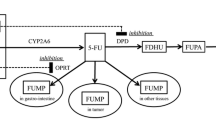Abstract
Purpose
This study evaluated the pharmacokinetic and safety profiles of arsenic trioxide given twice per week in adult cancer patients with advanced malignancies and varying degrees of renal function.
Methods
Patients received intravenous arsenic trioxide 0.15 mg/kg twice weekly for 4 weeks, followed by a 2-week rest period. The pharmacokinetic profiles of the pharmacologically active arsenical species, arsenious acid (AsIII), and its metabolites, monomethylarsonic acid (MMAV) and dimethylarsinic acid (DMAV), were evaluated during the first cycle for 72 h following doses on days 1 and 22. Safety assessments were made at each treatment visit.
Results
Twenty patients received an average of 11 doses. Compared with normal renal function, mild to severe renal impairment decreased urinary excretion of AsIII and increased exposure to MMAV and DMAV 1.4- to 8-fold after multiple dose administration. Only severe renal impairment substantially increased exposure to AsIII (AUC0–t increased by 18% after a single dose and 40% after multiple doses). The safety profile of arsenic trioxide after limited treatment on a twice-per-week schedule was comparable across all renal function groups.
Conclusion
Renal impairment did increase the systemic exposure to arsenic and its methylated metabolites following standard daily dosing of arsenic trioxide. The data from the limited number of patients with severe renal dysfunction did not suggest that severe renal impairment affected the safety profile of arsenic trioxide in cancer patients who received limited treatment with arsenic trioxide.


Similar content being viewed by others
References
Kwong YL, Todd D (1997) Delicious poison: arsenic trioxide for the treatment of leukemia. Blood 89(9):3487–3488
Soignet SL, Maslak P, Wang ZG et al (1998) Complete remission after treatment of acute promyelocytic leukemia with arsenic trioxide. N Engl J Med 339(19):1341–1348
Soignet SL, Frankel SR, Douer D et al (2001) United States multicenter study of arsenic trioxide in relapsed acute promyelocytic leukemia. J Clin Oncol 19(18):3852–3860
Shen Y, Shen ZX, Yan H et al (2001) Studies on the clinical efficacy and pharmacokinetics of low-dose arsenic trioxide in the treatment of relapsed acute promyelocytic leukemia: a comparison with conventional dosage. Leukemia 15(5):735–741
Mathews V, Balasubramanian P, Shaji RV, George B, Chandy M, Srivastava A (2002) Arsenic trioxide in the treatment of newly diagnosed acute promyelocytic leukemia: a single center experience. Am J Hematol 70(4):292–299
Mathews V, George B, Lakshmi KM et al (2006) Single-agent arsenic trioxide in the treatment of newly diagnosed acute promyelocytic leukemia: durable remissions with minimal toxicity. Blood 107(7):2627–2632
Munshi NC, Tricot G, Desikan R et al (2002) Clinical activity of arsenic trioxide for the treatment of multiple myeloma. Leukemia 16(9):1835–1837
Vey N, Bosly A, Guerci A et al (2006) Arsenic trioxide in patients with myelodysplastic syndromes: a phase II multicenter study. J Clin Oncol 24(16):2465–2471
Barbey JT, Pezzullo JC, Soignet SL (2003) Effect of arsenic trioxide on QT interval in patients with advanced malignancies. J Clin Oncol 21(19):3609–3615
Mathews V, Desire S, George B et al (2006) Hepatotoxicity profile of single-agent arsenic trioxide in the treatment of newly diagnosed acute promyelocytic leukemia, its impact on clinical outcome and the effect of genetic polymorphisms on the incidence of hepatotoxicity. Leukemia 20(5):881–883
Vahter M (1999) Methylation of inorganic arsenic in different mammalian species and population groups. Sci Prog 82(Pt 1):69–88
Vahter M (2002) Mechanisms of arsenic biotransformation. Toxicology 181–182:211–217
Aposhian HV, Aposhian MM (2006) Arsenic toxicology: five questions. Chem Res Toxicol 19(1):1–15
Chen GQ, Zhou L, Styblo M et al (2003) Methylated metabolites of arsenic trioxide are more potent than arsenic trioxide as apoptotic but not differentiation inducers in leukemia and lymphoma cells. Cancer Res 63(8):1853–1859
Styblo M, Del Razo LM, Vega L et al (2000) Comparative toxicity of trivalent and pentavalent inorganic and methylated arsenicals in rat and human cells. Arch Toxicol 74(6):289–299
Styblo M, Drobna Z, Jaspers I, Lin S, Thomas DJ (2002) The role of biomethylation in toxicity and carcinogenicity of arsenic: a research update. Environ Health Perspect 110(Suppl 5):767–771
Petrick JS, Jagadish B, Mash EA, Aposhian HV (2001) Monomethylarsonous acid (MMA(III)) and arsenite: LD(50) in hamsters and in vitro inhibition of pyruvate dehydrogenase. Chem Res Toxicol 14(6):651–656
US Food and Drug Administration (1998) Guidance for industry:pharmacokinetics in patients with impaired renal function-study design, data analysis, and impact on dosing and labeling. US Department of Health and Human Services, US Food and Drug Administration, Rockville
European Medicines Agency (2004) Note for guidance on the evaluation of the pharmacokinetics of medicinal products in patients with impaired renal function. European Medicines Agency, London
Fujisawa S, Ohno R, Shigeno K et al (2007) Pharmacokinetics of arsenic species in Japanese patients with relapsed or refractory acute promyelocytic leukemia treated with arsenic trioxide. Cancer Chemother Pharmacol 59(4):485–493
Acknowledgments
The authors gratefully acknowledge the editorial support provided by Bridget O’Keeffe, PhD, and Helix Medical Communications LLC. This study was funded by Cephalon, Inc., Frazer, Pennsylvania with additional support from NIH Grant No. M01 RR-000080 (SR) and NIH Grant GCRC M01RR00750 (CS).
Author information
Authors and Affiliations
Corresponding author
Rights and permissions
About this article
Cite this article
Sweeney, C.J., Takimoto, C., Wood, L. et al. A pharmacokinetic and safety study of intravenous arsenic trioxide in adult cancer patients with renal impairment. Cancer Chemother Pharmacol 66, 345–356 (2010). https://doi.org/10.1007/s00280-009-1169-4
Received:
Accepted:
Published:
Issue Date:
DOI: https://doi.org/10.1007/s00280-009-1169-4




